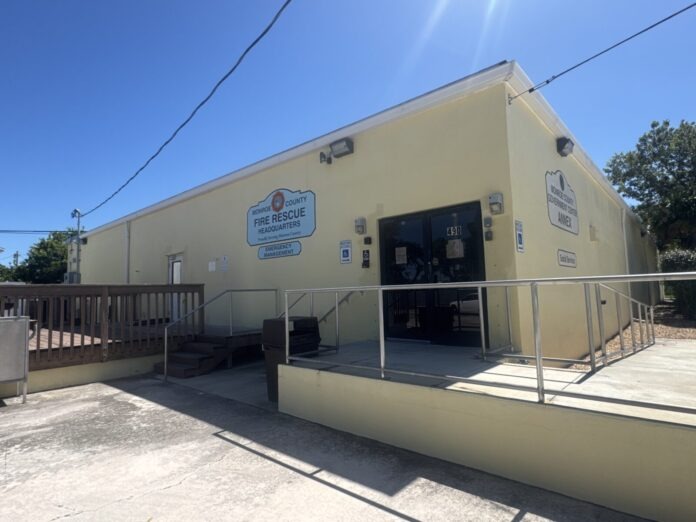
With just 21 days remaining before the Marathon City Council’s 2025 election, drastically different visions for how to handle the city’s affordable and workforce housing crises is one of several items separating candidates. Those views earned the spotlight on the dais at the council’s Oct. 14 session, sparked by a potential 19-unit affordable housing development on 63rd Street at the site of Monroe County’s old Emergency Operations Center.
Resolution 2025-97, pulled off the meeting’s consent agenda for discussion before approval in a 4-1 vote, allows for a transfer of 19 early-evacuation affordable housing units from Monroe County to Marathon for the build.
Funding for the project on the county-owned property would come from a $35 million surplus of Tourist Development Council revenues, approved by the state Legislature in 2024 for use in workforce housing projects benefiting tourism-related businesses.
The transfer was immediately challenged by councilman Kenny Matlock, an outspoken advocate for prioritizing single-family or duplex builds to answer affordable housing needs, not multifamily developments. His was the lone “no” vote on the resolution.
“At what point do we just stand back and go, we’re built out?” he said. “At some point you have to say no, because everyone who raises their hand for affordable housing, they’ll put 100 units on every street. … It’s not going to fix the problem, but it’s running our locals out of here.
“I don’t look at (affordable housing) as a favor. I look at it as, throw them on a plantation, because we need workers.”
Directly challenged by Matlock, Mayor Lynn Landry questioned the feasibility of replacing larger multi-unit builds with single-family homes in an island chain with limited land and few remaining building rights.
“You’re an investor in construction. I’m a contractor. We both know and fully understand what the cost of those single-family homes are,” he said. “So, you think just building single-family homes is going to be the answer to solving our affordable housing?”
“When I was on the workforce housing committee, (an FIU study) stated we needed roughly 1,600 units here in Marathon, and we built 1,000 units,” said Vice Mayor Jeff Smith. “When that study was done, we had 650 vacation rentals, which are now double that. So that housing stock has also gone offline to house our workers.
“That economic incentive is going to continue to take away the affordable housing stock, and our TBR (transferable building rights) process is going to continue to put pressure,” he added. “Where are we going to address the ability for these people to live in our community? The purpose of saying ‘I can’t build my way out’ (of the affordable housing crisis) was quite simply, I didn’t have units. These are units that exist in the community. We’re just saying, let’s move them on in here.”
Marathon Chamber of Commerce CEO Daniel Samess, who spoke in favor of the transfer during the meeting, later told the Weekly the project represented a rare opportunity, paid for by tourist dollars.
“Housing comes down to three things: the land, the units and the money,” he said. “This is a case that almost never happens where we have all three.”
In other news:
- Resolution 2025-94, extending the contract of city public information officer Carlos Garcia for one year at up to $100,000, was unanimously approved. Several council members praised Garcia’s work with video outreach and expanding the city’s social media channels, while Matlock questioned why the contract was extended four months into a six-month initial agreement and asked for updates on the city’s website upgrades.
- Ordinance 2025-06, also unanimously approved at its second hearing, provides slight changes to regulation of docks and waterfront walkways. Per the revised regulations, boat lifts may extend up to a maximum of eight feet above the dock’s walking surface. Fish cleaning tables, covered or uncovered, may also reach a maximum of eight feet above the dock, with one fish cleaning table allowed per slip at a maximum length of 9.5 feet.
- A development agreement for four single-family affordable homes built by QOF Inc. near 701 91st Street was tabled for further questioning and clarification regarding the need for the agreement.
- Ordinances 2025-07 and 2025-08, each approved 4-1 with revisions at their first reading, deals with the administration of designated early-evacuation affordable housing units. As initially proposed, the ordinance would allow developments owned by governments or housing authorities to circumvent a requirement of on-site property management. At the direction of the council, the ordinance will be changed to also allow privately-owned developments to use certified off-site property managers. Matlock was the lone “no” vote.
- Due to potential conflicts with Halloween festivities, the council elected to cancel its Oct. 28 workshop session.






















